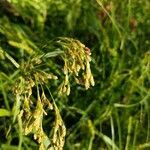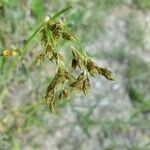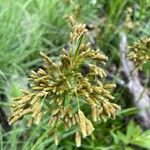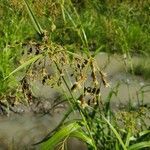Cespitose perennial to 1.5 m from short tough rhizomes; stems rigid, upright, with only a terminal infl or sometimes 1 or rarely 2 lateral infls; blades 3–10 mm wide; infl decompound; bracts usually shorter than the rays; spikelets elongating to 6–13 mm, usually 1 in each terminal cluster sessile and the others pedicellate, often drooping; scales obovate-elliptic, 1.7–2.2 mm, acuminate or conspicuously mucronate, with green midstrip and chestnut sides; bristles 6, brown, contorted, smooth, twice as long as the achene; style trifid; achene pale purple-brown to brown, compressed-trigonous, 1–1.3 mm, sharply short-beaked; 2n=40. Marshes and wet meadows; Me. to Minn., S.D., and Colo., s. to Fla., N.M., and n. Mex. Fr June, July. (S. lineatus, misapplied)





